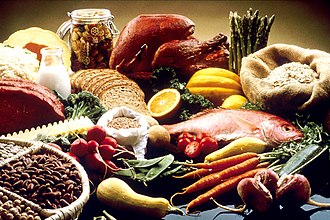**1. Food Sources and Consumption:**
– Humans consume a variety of foods such as vegetables, fruits, cooked meat, milk, eggs, mushrooms, seaweed, and cereal grains.
– Corn, wheat, and rice make up a significant portion of worldwide grain production.
– Edible fungi and bacteria are used in fermented foods like bread, wine, cheese, and yogurt.
– Aquatic foods, including fish and marine animals, contribute to the global food supply.
– Over 2,370 wild fish species and 624 farmed species are utilized for food.
– Different cultures have unique cuisines with specific cooking traditions and flavors.
**2. Taste Perception and Components:**
– Human taste perception includes sweet, sour, salty, bitter, and umami tastes.
– Sweetness is derived from simple sugars like glucose, fructose, or sucrose.
– Sourness comes from acids like vinegar and can indicate food spoilage.
– Saltiness is due to alkali metal ions like sodium and potassium.
– Bitterness is an unpleasant sensation found in foods like unsweetened dark chocolate and certain fruits.
– Umami is described as savory and is present in foods like broths, cooked meats, and soy sauce.
**3. Food Preparation and Cooking Techniques:**
– Food preparation involves safety, palatability, and flavor enhancement through methods like mixing, heating, cooling, and fermentation.
– Cooking techniques alter the flavor, texture, appearance, and nutritional properties of food.
– Various types of cooking equipment and cooktops are used for different culinary purposes.
– Grills in different cultures, such as American-style outdoor grills and Argentine asados, offer unique cooking methods.
– Restaurants play a crucial role in food service, with chefs preparing food and waiters serving customers.
**4. Economic Impact and Food Access:**
– Food systems have complex economic and social value chains.
– Global average daily calorie consumption and food imports are significant economic factors.
– Food access disparities exist based on socio-economic factors, affecting disadvantaged populations.
– Fluctuations in food prices due to geopolitical events and global demand can impact vulnerable populations.
– Food speculation can cause price swings in staple foods, leading to increased poverty or famine.
**5. Health and Nutrition:**
– MyPlate replaced MyPyramid as the USDA nutrition guide.
– Nutrition and dietary problems can lead to various health issues like obesity and cardiovascular diseases.
– Understanding the influence of diet on health is essential for optimal well-being.
– Diet-related disease states range from optimal health to malnutrition and starvation.
– The science of nutrition plays a crucial role in addressing food-related health issues.
Human food is food which is fit for human consumption, and which humans willingly eat. Not all things that are edible constitute human food. Food is a basic necessity of life, and humans typically seek food out as an instinctual response to hunger.

Humans eat various substances for energy, enjoyment and nutritional support. These are usually of plant, animal, or fungal origin, and contain essential nutrients, such as carbohydrates, fats, proteins, vitamins, and minerals. Humans are highly adaptable omnivores, and have adapted to obtain food in many different ecosystems. Historically, humans secured food through two main methods: hunting and gathering and agriculture. As agricultural technologies improved, humans settled into agriculture lifestyles with diets shaped by the agriculture opportunities in their region of the world. Geographic and cultural differences have led to the creation of numerous cuisines and culinary arts, including a wide array of ingredients, herbs, spices, techniques, and dishes. As cultures have mixed through forces like international trade and globalization, ingredients have become more widely available beyond their geographic and cultural origins, creating a cosmopolitan exchange of different food traditions and practices.
Today, the majority of the food energy required by the ever-increasing population of the world is supplied by the industrial food industry, which produces food with intensive agriculture and distributes it through complex food processing and food distribution systems. This system of conventional agriculture relies heavily on fossil fuels, which means that the food and agricultural system is one of the major contributors to climate change, accountable for as much as 37% of the total greenhouse gas emissions. Addressing the carbon intensity of the food system and food waste are important mitigation measures in the global response to climate change.
The food system has significant impacts on a wide range of other social and political issues, including: sustainability, biological diversity, economics, population growth, water supply, and access to food. The right to food is a "human right" derived from the International Covenant on Economic, Social and Cultural Rights (ICESCR), recognizing the "right to an adequate standard of living, including adequate food", as well as the "fundamental right to be free from hunger". Because of these fundamental rights, food security is often a priority international policy activity; for example Sustainable Development Goal 2 "Zero hunger" is meant to eliminate hunger by 2030. Food safety and food security are monitored by international agencies like the International Association for Food Protection, World Resources Institute, World Food Programme, Food and Agriculture Organization, and International Food Information Council, and are often subject to national regulation by institutions, such as the Food and Drug Administration in the United States.
